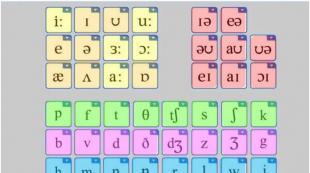English transcription: pronunciation of letters and sounds in English. English transcription of A as read in Russian
The English alphabet is based on the Latin alphabet and consists of 26 letters. Of these, 6 are vowels: A, E, I, O, U, Y.
20 consonants: B, C, D, F, G, H, J, K, L, M, N, P, Q, R, S, T, V, W, X, Z
The letter "Y" can convey both a vowel and a consonant. In combination with a vowel, the pronunciation is very close to Russian [й] and denotes the sounds [j] or [y]
yellow, yes, you, yard, young, yoga, yogurt
day, they, boy, toy, buy, eye
Forming syllables and being paired with a consonant, the letter “Y” conveys the vowel sound [i]
baby, mystery, system, funny
and sound [ai] in words
my, cry, analyze, cycle, sky, reply
In the alphabet, each letter has its own sound name, i.e. alphabetical reading.
Transcription signs are used to convey sounds in writing. Each sign corresponds to only one sound inherent to it. Transcription signs are written in square brackets: for example, the letter A and its alphabetical name (sound) is [ei].
In the alphabet, the letters are read unambiguously, one letter - one sound.
The letters Z and R are read differently in the British and American versions.
The British version of Z is (zed), the American version of Z is (zi).
The British version of R is (a), the American version of R is (ar).
Knowledge of the English alphabet is also necessary due to the discrepancy between the pronunciation of words and their spelling. Therefore, you may often be asked to repeat a word by letter - Can you spell that, please?
English alphabet with pronunciation and transcription
| Letter | Transcription | Pronunciation* | The sounds it conveys | |
| A a | Hey | , [æ] | ||
| Bb | bi | [b] | ||
| C c | si | [s] - before e, i, y [k] - in other cases |
||
| D d | di | [d] | ||
| E e | And | ,[e] | ||
| F f | ef | [f] | ||
| G g | ji | , [g] | ||
| H h | HH | [h] | ||
| I i | ah | ,[i] | ||
| Jj | Jay | |||
| K k | Kay | [k] | ||
| L l | el | [l] | ||
| Mm | Em | [m] | ||
| Nn | en | [n] | ||
| O o | OU | , [ɔ] | ||
| P p | pi | [p] | ||
| Q q | Cue | |||
| R r | ar | [r] | ||
| Ss | es | [s], [z] | ||
| T t | you | [t] | ||
| U u | Yu | , [ʌ], [u] | ||
| V v | in and | [v] | ||
| W w | ["dʌbl ju:] | double u | [w] | |
| X x | the ex | , | ||
| Y y | wy | [j] | ||
| Z z | () | zi (zed) | [z] | |
* In the column " Pronunciation"Given in Russian letters the approximate sound of the letter names. And in the column " Transcription" a more accurate pronunciation is given using phonetic transcription.
“I don’t understand transcription”, “How is this written in Russian letters?”, “Why do I need these sounds?”... If you start learning English with such sentiments, then I will have to disappoint you: it is unlikely that you will achieve significant good luck in English.
Without mastering transcription, it will be difficult for you to understand the structure of English pronunciation; you will constantly make mistakes and experience difficulties when learning new words and using dictionaries.
Ever since school, the attitude of many towards transcription has been openly negative. In fact, there is nothing complicated in English transcription. If you do not understand it, then this topic was not explained to you properly. In this article we will try to fix this.
To understand the essence of transcription, you must clearly understand the difference between letters and sounds. Letters- this is what we write, and sounds- what we hear. Transcription marks are the sounds represented in writing. For musicians this role is played by notes, but for you and me - transcription. In Russian, transcription does not play such a big role as in English. There are vowels that are read differently, combinations that need to be remembered, and letters that are not pronounced. The number of letters and sounds in a word does not always coincide.
For example, the word daughter has 8 letters and four sounds ["dɔːtə]. If the final [r] is pronounced, as in American English, then there are five sounds. The combination of vowels au gives the sound [ɔː], gh is not readable at all, er may be read as [ə] or [ər], depending on the variety of English.
There are a huge number of similar examples. It is difficult to understand how to read a word and how many sounds are pronounced in it if you do not know the basic rules of transcription.
Where can I find the transcription? First of all, in dictionaries. When you find a new word in the dictionary, there must be information nearby about how the word is pronounced, that is, a transcription. In addition, in textbooks the lexical part always contains transcription. Knowledge of the sound structure of a language will not allow you to remember the incorrect pronunciation of words, because you will always identify a word not only with its letter representation, but also with its sound.
In domestic publications, transcriptions are usually placed in square brackets, while in dictionaries and manuals from foreign publishers, transcriptions are presented in oblique brackets / /. Many teachers use slashes when writing transcriptions of words on the board.
Now let's learn more about the sounds of the English language.
There are only 44 sounds in the English language, which are divided into vowels(vowels ["vauəlz]), consonants(consonants "kɔn(t)s(ə)nənts]). Vowels and consonants can form combinations, including diphthongs(diphthongs ["dɪfθɔŋz]). Vowel sounds in English vary in length by brief(short vovels) and long(long vowels), and consonants can be divided into deaf(voices consonants), voiced(voiced consonants). There are also those consonants that are difficult to classify as voiceless or voiced. We will not delve into phonetics, since at the initial stage this information is quite enough. Consider the table of English sounds:

Let's start with vowels. Two dots near the symbol indicate that the sound is pronounced for a long time; if there are no dots, then the sound should be pronounced briefly. Let's see how vowel sounds are pronounced:
- long sound I: tree, free
[ɪ ] - short sound I: big, lip
[ʊ] - short sound U: book, look
- long sound U: root, boot
[e] - sound E. Pronounced the same way as in Russian: hen, pen
[ə] is a neutral sound E. It sounds when the vowel is not under stress or at the end of a word: mother ["mʌðə], computer
[ɜː] is a sound similar to the sound Ё in the word honey: bird, turn
[ɔː] - long sound O: door, more
[æ] - sound E. Pronounced widely: cat, lamp
[ʌ] - short sound A: cup, but
- long sound A: car, mark
[ɒ] - short sound O: box, dog
Diphthongs- these are combinations of sounds consisting of two vowels, always pronounced together. Let's look at the pronunciation of diphthongs:
[ɪə] - IE: here, near
— Uh: fair, bear
[əʊ] - EU (OU): go, no
- AU: how, now
[ʊə] - UE: sure [ʃuə], tourist ["tuərɪst]
- HEY: make, day
- AI: my, bike
[ɔɪ] - OH: : boy, toy
Let's consider consonants sounds. Voiceless and voiced consonants are easy to remember, since each of them has a pair:
| Voiceless consonants: | Voiced consonants: |
|---|---|
| [p] - P sound: pen, pet | [b] - sound B: big, boot |
| [f] - F sound: flag, fat | [v] - sound B: vet, van |
| [t] - T sound: tree, toy | [d] - sound D: day, dog |
| [θ] is an interdental sound that is often confused with C, but when pronounced, the tip of the tongue is between the lower and upper front teeth: thick [θɪk], think [θɪŋk] |
[ð] is an interdental sound that is often confused with Z, but when pronounced, the tip of the tongue is located between the lower and upper front teeth: this [ðɪs], that [ðæt] |
| [tʃ] - sound Ch: chin [ʧɪn], chat [ʧæt] | [dʒ] - J sound: jam [ʤæm], page |
| [s] - sound C: sit, sun | [z] - sound Z: |
| [ʃ] - sound Ш: shelf [ʃelf], brush | [ʒ] - sound Ж: vision ["vɪʒ(ə)n], decision |
|
[k] - sound K: kite, cat |
[g] - sound G: get, go |
Other consonants:
[h] - sound X: hat, home
[m] - M sound: make, meet
[n] - English sound N: nose, net
[ŋ] - a sound reminiscent of N, but pronounced through the nose: song, long - a sound reminiscent of P: run, rest
[l] - English sound L: leg, lip
[w] - a sound reminiscent of B, but pronounced with rounded lips: ,west
[j] - sound Y: you, music ["mjuːzɪk]
Those who want to gain a deeper understanding of the phonetic structure of the English language can look for resources on the Internet where they will tell you what sonorant, stop, fricative and other consonants are.
If you just want to understand the pronunciation of English consonant sounds and learn to read transcriptions without unnecessary theory, then we recommend sharing everything consonants sounds for the following groups:
- Sounds that pronounced almost the same as in Russian : This is the majority of consonants.
- Sounds that similar to those in Russian , but are pronounced differently. There are only four of them.
- The sounds that no in Russian . There are only five of them and it is a mistake to pronounce them the same way as in Russian.

Pronunciation of sounds marked yellow, practically no different from Russian, only sounds [p, k, h] are pronounced with “aspiration”.
Green sounds- these are the sounds that need to be pronounced in the English manner; they are the reason for the accent. The sounds are alviolar (you probably heard this word from your school teacher), to pronounce them, you need to raise your tongue to the alviols, then you will sound “English”.
Sounds tagged red, are not present in Russian at all (although some people think that this is not the case), so you must pay attention to their pronunciation. Do not confuse [θ] and [s], [ð] and [z], [w] and [v], [ŋ] and [n]. There are fewer problems with the [r] sound.
Another nuance of transcription is emphasis, which is marked with an apostrophe in transcription. If a word has more than two syllables, then stress is required:
Hotel -
police -
interesting — ["ɪntrəstɪŋ]
When a word is long and polysyllabic, it may contain two accents, and one is upper (main), and the second is lower. The lower stress is indicated by a sign similar to a comma and is pronounced weaker than the upper:
disadvantage - [ˌdɪsəd"vɑːntɪʤ]
As you read the transcription, you may notice that some sounds are presented in parentheses (). This means that the sound can be read in a word, or it can be left unpronounced. Usually in brackets you can find the neutral sound [ə], the sound [r] at the end of a word, and some others:
Information — [ˌɪnfə"meɪʃ(ə)n]
teacher — ["tiːʧə(r)]
Some words have two pronunciation options:
Forehead ["fɔrɪd] or ["fɔːhed]
Monday ["mʌndeɪ] or ["mʌndɪ]
In this case, choose the option that you prefer, but remember that this word can be pronounced differently.
Many words in English have two pronunciations (and, accordingly, transcriptions): in British English and in American English. In this situation, learn the pronunciation that corresponds to the version of the language you are studying, try not to mix words from British English and American English in your speech:
Schedule - ["ʃedjuːl] (BrE) / ["skeʤuːl] (AmE)
neither - ["naɪðə] (BrE) / [ˈniːðə] (AmE)
Even if you couldn’t stand transcription before, after reading this article you will see that reading and composing a transcription is not at all difficult! You were able to read all the words written down in the transcription, right? Apply this knowledge, use dictionaries and be sure to pay attention to the transcription if you have a new word in front of you, so that you remember the correct pronunciation from the very beginning and do not have to relearn it later!
Stay up to date with all the updates on our website, subscribe to our newsletter, join us V
So, here we are at the last sixth vowel of the English alphabet letter Uu. If you have studied reading rules inEnglish language According to our recommendations, you already have sufficient theoretical knowledge. However, practice is most likely not enough. However, this is not the end of our reading course. Practice awaits you ahead. More on this a little later.
In Lesson #25 you will learn:
- how to read a letter Uu in English;
- repeat the pronunciation of sounds , [ʌ], [ə:], .
Rules for reading the English letter U
Here are phrases to help you remember reading the letter U in each syllable type. There is a dictionary connected to the site and, if in doubt, click on a word and listen to how it is pronounced.
Reading the English letter U in 4 syllable types. Tongue Twisters
1. : I don’t like u sual t u nes in m u sic. — I don’t like ordinary melodies.
2. [ʌ]: Have l u nch with u s. -Have lunch with us.
3. [ə:]: I have a p ur ple p ur se. — I have a purple wallet.
4. : I am s ure. - I'm sure.
Phonetic exercises for reading the letter U in open and closed syllables
U (I, II):
fun, music, plum, cube, pumpkin, rubber, super, drum, student, stupid, hunting, hungry, tune, tunic, luck, supper, super, to return, curl, sunny, pupil, blue, uniform, summer, suck , unit, due, ugly, mutton, butter, struggle, to construct, to consult, cluster, dub, drunk, true, tulip, use, upland, under, computer, cucumber, buck, must, to amuse, mummy, truth, gum, bubble, much, huge
to– sign of a verb. Most verbs have stress on the second syllable
Exceptions:
1. after letters l, r, j vowel U often read as: blue, true, truth, June, July,
2. after letters b, p, f vowel in a closed syllable U often read as [u]: full, bush, put, pull, etc.
Words to remember:
- busy [‘bizi] - busy
- study [‘stʌdɪ] - to study
- sugar [‘∫ugə] - sugar
Your browser does not support the audio tag!
Phonetic exercises for reading the letter U in the third and fourth syllable type
U (III, IV):
church, turn, burn, to return, pure, curl, curb, fur, hurt, sure, nurse, curse, curt, burning, turning, turkey, lure
In an unstressed syllable U is read as [ə]:
to s u ppose ,`fig u re [‘fɪgə], `maxim u m [‘mæksɪməm]
Phonetic exercises for practicing reading the letter U with audio recording and answers (closed content)
Paid content is hidden. Registered users who have paid for access have the right to view paid content.
Title: Phonetic exercises with audio recording
Description: Access to restricted content *Repeat the rules for reading in English*
Reading the letter combination UI:
3. UI read
– in a closed syllable after n,
s: suit - suit, nuisance [‘nju:səns] - annoyance. Exception: suite - hotel room
Your browser does not support the audio tag!
Reading the letter combination QU
1. qu read
almost always: qu ick qu ickly qu iet, qu ietly, qu estion, qu iz, qu it, qu ite, s qu irrel, qu ail, qu ill, qu ilt, qu arter
Your browser does not support the audio tag!
Don't be confused: qu ite — quite And qu iet - quiet
This was the last lesson of the course "Teaching English reading and pronunciation at the same time." In conclusion, I would like to once again draw your attention to the fact that in the first 20 lessons I relied on reading teaching method "from sound to letter" and in the last 5 lessons on reading teaching method "from letter to sound" and finally the circle is closed. There is an English expression “to round up”. I hope that you now have sufficient theoretical knowledge to, as a reinforcement, study on your own a few more articles, namely:
Transcription- this is a written representation of the sounds of a language using special signs, with the goal of accurately conveying pronunciation. International transcription is used as the main one. With its help, you can record the sound of any word, regardless of whether it belongs to any language.
International Phonetic Alphabet(English) International Phonetic Alphabet, abbr. IPA; fr. Alphabet telephonique international, abbr. API) - a system of characters for recording transcription based on the Latin alphabet. Developed and maintained by the International Phonetic Association IPA. Symbols for the IPA were chosen to be harmonious with the Latin alphabet. Therefore, most of the characters are letters of the Latin and Greek alphabets or modifications thereof. Many British dictionaries, including educational dictionaries, such as Oxford Advanced Learner's Dictionary And Cambridge Advanced Learner's Dictionary, now use the international phonetic alphabet to convey the pronunciation of words. However, most American publications (and some British ones) use their own notation, which is considered more intuitive for readers unfamiliar with IPA.
A colon after the sign means that the sound is long and needs to be pronounced a little longer. In English dictionaries there are two types of stress, primary and secondary, and both are placed before the stressed syllable. In transcription, the main emphasis is placed at the top - [... ʹ
...], and the secondary one is below [... ͵
...]. Both types of stress are used in polysyllabic and compound words. It is also worth mentioning that there are rules under which some sounds and letters are not pronounced. In transcription they are placed in parentheses - [.. (..)
..].
Transcription signs
used in suggested dictionaries and articles with pronunciation examples
| Vowel sounds | |||
|---|---|---|---|
| Close to yarn And in a word And va | f ee l |
||
| [ı] | Close to short And in a word And gla |
f i ll |
|
| [e] | The transcription sign is similar to uh in a word This |
f e ll |
|
| [æ] | - average between A And uh. Open your mouth as if to pronounce A, try to pronounce uh. |
c a t |
|
| [ɑ:] | Long sound ah-ah:d ah-ah th | c a rt |
|
| [ɒ] | Brief O in a word T O T | c o t |
|
| [ɔ:] | Reminds me of something drawn out O in a word P O full | f a ll |
|
| [ɜ:] | Long sound, medium between O And: uh... Reminds me e in a word G e those | c u rt |
|
| [ə] | A short, unclear, unimpacted sound. In Russian it is heard in unstressed syllables: five room A T | b a nan a |
|
| [ʌ] | Close to unstressed A in a word To A mouse.In English it is usually stressed | c u t |
|
| [ʋ] | Close to the sound at in a word T at T | f u ll |
|
| Close to sound at, pronounced in a drawn-out manner: at-smart | f oo l |
||
| Close to Russian ah in a word B ah feces | f i le |
||
| to her in a word w to her ka | f ai l |
||
| [ɔı] | Ouch in a word b Ouch nya | f oi l |
|
| aw in a word P aw behind | f ou l |
||
| [əʋ] | f oa l |
||
| [ıə] | Combination [ı] and [ə] with emphasis on [ı]. Approximately Ie | t ie r |
|
| [ʋə] | Combination [ʋ] and [ə] with emphasis on [ʋ] Approximately Ue | t ou r |
|
| The first element of the combination is close to uh in a word uh That. It is followed by a quick sound [ə] . The combination is roughly pronounced Ea | t ea r |
||
| Consonants | |||
|---|---|---|---|
| [p] | resp. Russian Pp ier |
||
| [t] | resp. Russian T | t ier |
|
| [b] | resp. Russian b | b eer |
|
| [d] | resp. Russian d | d eer |
|
| [m] | resp. Russian m | m ere |
|
| [n] | resp. Russian n | n ear |
|
| [k] | resp. Russian To | ba k e |
|
| [l] | resp. Russian l | l eer |
|
| [g] | resp. Russian G | g ear |
|
| [f] | resp. Russian f | f ear |
|
| [v] | resp. Russian V | v eer |
|
| [s] | resp. Russian With | ba s e |
|
| [z] | resp. Russian h | bai z e |
|
| [ʃ] | resp. Russian w | sh eer [ʃıə] |
|
| [ʒ] | resp. Russian and | bei g e |
|
| resp. Russian h | ch eer |
||
| resp. Russian j | j eer |
||
| [r] | matches the sound R in a word and R fuck | r ear |
|
| [h] | exhalation, reminiscent of a faintly pronounced sound X |
h ear |
|
| [j] | reminds me of Russian sound th before vowels: New Y orc, If[yeasley]. Occurs in combination with vowels. | y ear |
|
| long Yu in a word Yu gentle | |||
| e in a word e l | |||
| e in a word e lk | |||
| I in a word I ma | |||
| The following consonant sounds do not even have approximate correspondences in Russian | |||
|---|---|---|---|
| [w] | sound V uttered with just lips. In translation it is indicated by letters V or at: W Williams U Ilyama, IN Ilyama | w eir |
|
| [ŋ] | Open your mouth slightly and say n without closing your mouth | wro ng |
|
| [θ] | Move the slightly spread tip of your tongue between your teeth and say Russian With | wra th |
|
| [ð] | With the same tongue position, say h. | th is [ðıs] |
|
In site documents and dictionary entries, both the new version of the international transcription of the English language, that is, the one that has become widespread recently, and the old version are used. Both transcription options differ only in the outline of some sounds.
Changes in the new transcription
| Old form | For example | New form |
|---|---|---|
| f ee l | ||
| [i] | f i ll | [ı] |
| [e] | f e ll | [e] |
| [ɔ:] | f a ll | [ɔ:] |
| [u] | f u ll | [ʋ] |
| f oo l | ||
| f ai l | ||
| f oa l | [əʋ] | |
| f i le | ||
| f ou l | ||
| [ɔi] | f oi l | [ɔı] |
| [æ] | c a t | [æ] |
| [ɔ] | c o t | [ɒ] |
| [ʌ] | c u t | [ʌ] |
| [ə:] | c u rt | [ɜ:] |
| [ɑ:] | c a rt | [ɑ:] |
| t ie r | [ıə] | |
| [ɛə] | t ea r | |
| t ou r | [ʋə] | |
| [ə] | b a nan a | [ə] |
English is the business slang of the entire modern world. Businessmen and entrepreneurs speak English. In addition, it is easiest to find any information in this language. So its importance cannot be underestimated.
To communicate, you need to understand the principles of pronunciation and phonetics of the language. While this is not so important for reading or writing, oral communication depends on how you pronounce words. A slight accent is even interesting, but if you cannot understand the meaning of the speech, there is no point in such a conversation.
English alphabet
If in Russian, your native language, there are thirty-one letters, of which ten are vowels and twenty-one consonants, then with English the situation is different. There are the same number of consonants here, and here they are: b, c, d, f, g, h, j, k, l, m, n, p, q, r, s, t, v, w, x, y, z. There are only five vowels - a, e, i, o, u.
- The English language is not a homogeneous substance, but many different dialects - about two dozen. This does not change the alphabet, but the pronunciation may be greatly distorted. Don't try to fake the accent of the former British colony, just speak as you are used to. American English with a slight accent is usually sufficient for conversation.
- By the way, the American dialect is the easiest to learn. Grammatical and phonetic rules are simplified to the limit.
- If you come across the sentence: "The quick brown fox jumps over the lazy dog", don't try to understand the meaning. This is a test phrase for checking fonts - not surprising, since it contains every letter of the English alphabet.
- You don’t need to learn a lot of words to communicate normally - the main thing is to know the basic social markers. Like action verbs, nouns and pronouns, as well as numerals and a number of adjectives. Still, you won’t be able to learn the language completely - after all, every hour and a half, a new word enters the slang of English speakers.
How to pronounce the alphabet correctly
Some points in the English language can cause inconvenience for an unprepared person.
This is due to the fact that you need to make a sound without saying it - the wording is quite strange, but it works that way. For example, such a popular word as airplane is airplane.
For Russian speakers, it will be pronounced approximately like this [eyaplein], with almost no sound [a]. Or, the name of the famous group “Thirty Seconds to Mars” - two words are interesting here. The first will be discussed a little later, since it also touches on another problem, but the second, Mars, will be pronounced like [Ma:s].
Thirty addresses the problem - sound [ θ ], which occurs when combined in a wordth – it will be pronounced elongated [c]. That is, you will say the word indicated earlier as [Syooti], and the double [o] will also mean [r].
Vowels and their pronunciation
| Letter | Transcription | Russian pronunciation |
| A/a | Hey | |
| And | ||
| ah | ||
| [əu] | OU | |
| Yu |
Consonants and their pronunciation
| Letter | Transcription | Russian pronunciation |
| B/ b | [bi:] | bi |
|
C/ c |
si | |
|
D/ d |
di | |
|
F/ f |
ef | |
| ji | ||
|
H/ h |
HH | |
| Jay | ||
| kay | ||
| el | ||
| Em | ||
| en | ||
| pi | ||
| Cue | ||
| R/r | [α:] | ah-ah (pronounced with a voiceless ar How through the nose) |
| S/s | es | |
| you | ||
| in and | ||
| [΄dΛblju:] | double | |
| the ex | ||
| wai | ||
| zed |









